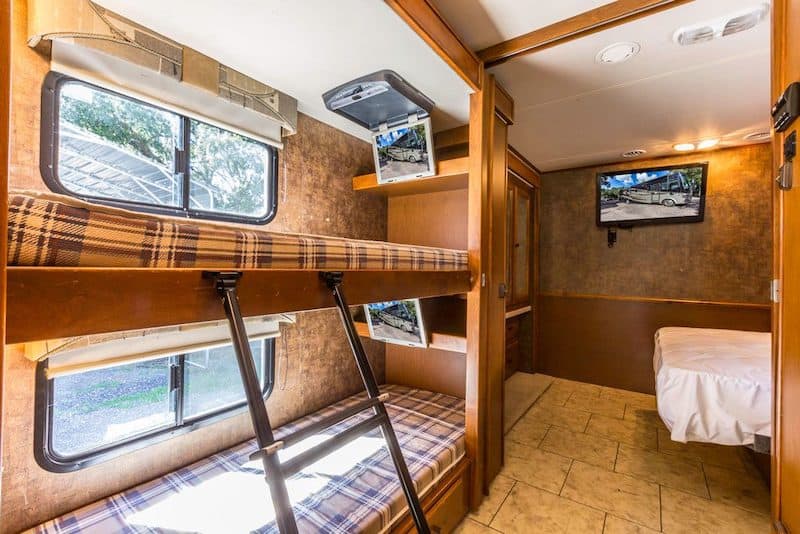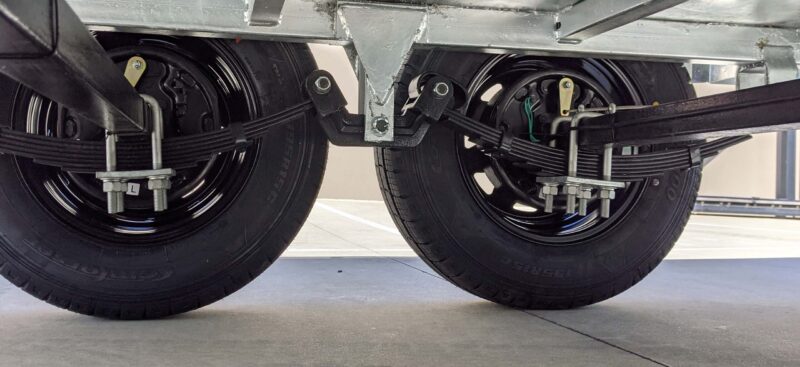“How much weight do RV bunks hold?” is a question that often arises among families and groups planning their next RV adventure or RV purchase.
Because of their compact size and convenience, RV bunks are an exceptional choice when traveling with children. However, understanding the weight capacity of these bunks is crucial for safety and comfort during your journey.
The problem is that the weight rating information attached to each bunk may fade over time, leaving many RVers in the dark about this critical detail.
Adhering to these weight ratings is not merely a suggestion but a vital safety measure you should diligently follow.
In this blog post, we dive deep into the specifics of RV bunk weight capacities to ensure a safe and enjoyable RVing experience for all passengers.
What Is An RV Bunk?
An RV bunk refers to bunk beds installed within a recreational vehicle.
Two beds are stacked one above the other to create a space-saving option for families or groups traveling in an RV.
Bunk beds often come with foam mattresses and are smaller than standard beds, making them more suitable for children or small adults.
RV manufacturers often feature these beds in dedicated ‘bunkhouse’ sections within the RV layout, allowing for efficient vertical space use.
Are Bunk Houses And Bunk Beds The Same Thing?
While related, a bunkhouse and bunk beds are different.
Bunk beds allow two or more people to sleep in the same room while maximizing available floor space by stacking one bed frame on top of another.
A bunkhouse refers to a specific layout or section within an RV that houses sleeping quarters, often including bunk beds, but not always. A bunkhouse could just as quickly contain two separate beds not stacked on each other.
The critical aspect of a bunkhouse is that it’s a dedicated space for sleeping within the RV, usually separated from the main living area for privacy and quiet.
Most bunkhouses contain bunk beds because of their space-saving benefits, but it’s not a strict requirement.
How Much Weight Do RV Bunks Hold?
The weight capacity of RV bunks can vary significantly depending on the specific model and manufacturer of the RV. However, as a general rule, most RV bunk beds can hold between 150 to 300 lbs.
The size of the bunk (single or double) also impacts the weight it can handle. It’s crucial to check the RV manual or consult the manufacturer to get the accurate weight limit for the specific model you own or are considering purchasing.
To ensure safety and prevent accidents, manufacturers recommend that lighter persons use the top bunk when possible.
Overloading a bunk bed can damage not only the bed itself but potentially the structure of the RV. RV bunks are affixed to the wall studs of the RV, a critical structural component of the RV.
How Do I Find The Weight Rating On My RVs Bunks?
To find the weight rating on your RV’s bunks, check for any labels or stickers in the bunk area first. Manufacturers often post this information directly on the bunk beds for easy reference.
Usually, these labels are on the bunk bed frame or underneath the mattress. Contact the RV’s manufacturer or dealer if you don’t see any labels or the information is unclear. They should be able to provide accurate weight limits for the specific model of your RV.
If you’re unsure of the weight limit, assuming a lower limit is safer to prevent any potential damage or accidents. Overloading a bunk bed could lead to structural issues with the bed and the RV itself and, more importantly, injury to persons.
Why Do RV Bunks Have Weight Ratings?
RV bunks have weight ratings primarily for safety reasons. The weight rating is determined by the construction of the bunk bed’s frame and platform and how it’s attached to the RV wall. Exceeding the weight limit could result in collapse, leading to injury. This is the main reason for weight ratings.
Bunk weight limits vary, ranging from 150 to 350 pounds, depending on the model and build of the RV. This is a large range due to the fact that the size of the bed, the materials used and how it’s attached to the RV wall all play a factor.
Just as all RVs have different weight ratings, bunks are the same. The manufacturer designs and builds bunks to a certain spec for each model. How much weight do RV bunks hold is a question with a different answer depending on your RV.
Another reason for the weight rating is to protect the manufacturer from liability. The manufacturer includes a weight rating in their safety guidelines to avoid liability.
By stating a max weight rating, the manufacturer has done its due diligence to keep users safe.
Can I Add Bunks To My RV?
Yes, you can add bunks to your RV, but it’s not a common practice, and several essential considerations exist.
First, the RV walls and floors must be structurally capable of supporting the extra weight. The answer will rely on the construction and design of your particular RV model.
When your RV was built, the weight of all the components and their location on the floorplan are all considered. Adding weight to a certain area of the RV or putting added stress on an area not designed for it can cause problems.
Second, changing your RV by adding bunks could void any warranties you have on the vehicle. It’s recommended to check with your manufacturer or dealer before significantly modifying your RV.
Last, if you don’t have construction or carpentry experience, hire a professional to install the bunks safely and securely.
What Types Of RVs Have Bunks?
All RVs can have bunk beds, most commonly found in larger models designed for families or groups.
Here are some examples:
- Travel Trailers: Many travel trailers, especially those designed for families, feature bunk bed floor plans.
- Fifth Wheels: These larger RVs often have a separate ‘bunkhouse’ area with multiple bunk beds, perfect for children or guests.
- Class A Motorhomes: Some Class A motorhomes, especially those designed for family travel, may include one or more bunk beds.
- Class C Motorhomes: Class C RVs often feature a bunk over the cab area, and some models also include additional bunk beds.
- Toy Haulers: Some toy haulers feature fold-down bunks in the garage area, providing extra sleeping space once the ‘toys’ (like ATVs or motorcycles) are unloaded.
Remember, the availability of bunks and their specific design can vary depending on the RV’s make, model, and year.
Always check the floor plan and specifications when considering an RV purchase.
Can I Use My RV Bunks for Storage While Traveling?
Yes, you can certainly use your bunks for storage while traveling, but be careful not to overload your bunks with heavy gear. The weight of your gear is magnified by the bouncing of your RV while driving down the road.
Final Thoughts: How Much Weight Do RV Bunks Hold?
RV bunk weights can vary depending on the specific make and model of the RV. Most commonly, the weight capacity for RV bunks ranges between 150 to 350 pounds.
However, there are some exceptions. For example, according to a user on iRV2 Forums, the manufacturer states if your RV has a Happijac bed lift system (an electric bunk), it can hold up to 600 pounds!
The weight limit may also be higher for the bottom bunk than the top bunk. This is common and makes sense seeing that the top bunk is the one suspended above the other.
The structural integrity of the bottom bunk is typically greater, as it is situated closer to the ground and may even have supplementary reinforcement.
Checking the specific weight limit for the bunks in your RV is crucial. To find this information, refer to the manual of your RV or check the label attached to the bunk.
RV bunk weight ratings are not just random numbers they are specific parameters set by the manufacturer for your safety. You can sleep sound at night knowing everyone in your RV is safely tucked into bed.
Related Reading:
– 15 Awesome Travel Trailers With bunks
– 10 Best Travel Trailers With A Bunk House
– 14 Best Travel Trailers With Murphy Beds
– 12 Best Travel Trailers For Families
About the Author:
Mike Scarpignato is an avid RVer who owns a Class C RV and a Class A RV. He loves to travel with his wife Susan and write blog articles about the RV lifestyle.
Mike and Susan also make YouTube videos on the RVBlogger YouTube channel.




